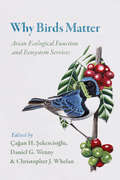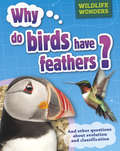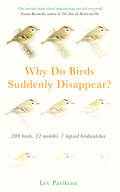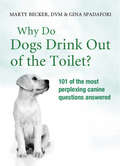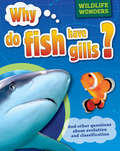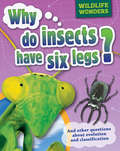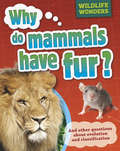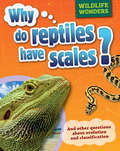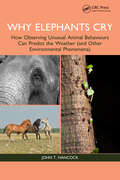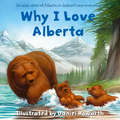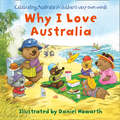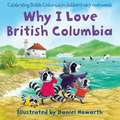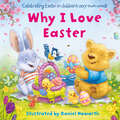- Table View
- List View
Why Birds Matter: Avian Ecological Function and Ecosystem Services
by Çağan H. Şekercioğlu, Daniel G. Wenny, and Christopher J. Whelan Daniel G. Wenny Christopher J. WhelanFor over one hundred years, ornithologists and amateur birders have jointly campaigned for the conservation of bird species, documenting not only birds’ beauty and extraordinary diversity, but also their importance to ecosystems worldwide. But while these avian enthusiasts have noted that birds eat fruit, carrion, and pests; spread seed and fertilizer; and pollinate plants, among other services, they have rarely asked what birds are worth in economic terms. In Why Birds Matter, an international collection of ornithologists, botanists, ecologists, conservation biologists, and environmental economists seeks to quantify avian ecosystem services—the myriad benefits that birds provide to humans. The first book to approach ecosystem services from an ornithological perspective, Why Birds Matter asks what economic value we can ascribe to those services, if any, and how this value should inform conservation. Chapters explore the role of birds in such important ecological dynamics as scavenging, nutrient cycling, food chains, and plant-animal interactions—all seen through the lens of human well-being—to show that quantifying avian ecosystem services is crucial when formulating contemporary conservation strategies. Both elucidating challenges and providing examples of specific ecosystem valuations and guidance for calculation, the contributors propose that in order to advance avian conservation, we need to appeal not only to hearts and minds, but also to wallets.
Why Birds Matter: Avian Ecological Function and Ecosystem Services
by Çağan H. Şekercioğlu, Daniel G. Wenny, and Christopher J. Whelan Daniel G. Wenny Christopher J. WhelanFor over one hundred years, ornithologists and amateur birders have jointly campaigned for the conservation of bird species, documenting not only birds’ beauty and extraordinary diversity, but also their importance to ecosystems worldwide. But while these avian enthusiasts have noted that birds eat fruit, carrion, and pests; spread seed and fertilizer; and pollinate plants, among other services, they have rarely asked what birds are worth in economic terms. In Why Birds Matter, an international collection of ornithologists, botanists, ecologists, conservation biologists, and environmental economists seeks to quantify avian ecosystem services—the myriad benefits that birds provide to humans. The first book to approach ecosystem services from an ornithological perspective, Why Birds Matter asks what economic value we can ascribe to those services, if any, and how this value should inform conservation. Chapters explore the role of birds in such important ecological dynamics as scavenging, nutrient cycling, food chains, and plant-animal interactions—all seen through the lens of human well-being—to show that quantifying avian ecosystem services is crucial when formulating contemporary conservation strategies. Both elucidating challenges and providing examples of specific ecosystem valuations and guidance for calculation, the contributors propose that in order to advance avian conservation, we need to appeal not only to hearts and minds, but also to wallets.
Why Birds Matter: Avian Ecological Function and Ecosystem Services
by Çagan H. Sekercioglu Daniel G. Wenny Christopher J. WhelanFor over one hundred years, ornithologists and amateur birders have jointly campaigned for the conservation of bird species, documenting not only birds’ beauty and extraordinary diversity, but also their importance to ecosystems worldwide. But while these avian enthusiasts have noted that birds eat fruit, carrion, and pests; spread seed and fertilizer; and pollinate plants, among other services, they have rarely asked what birds are worth in economic terms. In Why Birds Matter, an international collection of ornithologists, botanists, ecologists, conservation biologists, and environmental economists seeks to quantify avian ecosystem services—the myriad benefits that birds provide to humans. The first book to approach ecosystem services from an ornithological perspective, Why Birds Matter asks what economic value we can ascribe to those services, if any, and how this value should inform conservation. Chapters explore the role of birds in such important ecological dynamics as scavenging, nutrient cycling, food chains, and plant-animal interactions—all seen through the lens of human well-being—to show that quantifying avian ecosystem services is crucial when formulating contemporary conservation strategies. Both elucidating challenges and providing examples of specific ecosystem valuations and guidance for calculation, the contributors propose that in order to advance avian conservation, we need to appeal not only to hearts and minds, but also to wallets.
Why Birds Matter: Avian Ecological Function and Ecosystem Services
by Cagan Sekercioglu Daniel G. Wenny Christopher J. WhelanFor over one hundred years, ornithologists and amateur birders have jointly campaigned for the conservation of bird species, documenting not only birds’ beauty and extraordinary diversity, but also their importance to ecosystems worldwide. But while these avian enthusiasts have noted that birds eat fruit, carrion, and pests; spread seed and fertilizer; and pollinate plants, among other services, they have rarely asked what birds are worth in economic terms. In Why Birds Matter, an international collection of ornithologists, botanists, ecologists, conservation biologists, and environmental economists seeks to quantify avian ecosystem services—the myriad benefits that birds provide to humans. The first book to approach ecosystem services from an ornithological perspective, Why Birds Matter asks what economic value we can ascribe to those services, if any, and how this value should inform conservation. Chapters explore the role of birds in such important ecological dynamics as scavenging, nutrient cycling, food chains, and plant-animal interactions—all seen through the lens of human well-being—to show that quantifying avian ecosystem services is crucial when formulating contemporary conservation strategies. Both elucidating challenges and providing examples of specific ecosystem valuations and guidance for calculation, the contributors propose that in order to advance avian conservation, we need to appeal not only to hearts and minds, but also to wallets.
Why Birds Matter: Avian Ecological Function and Ecosystem Services
For over one hundred years, ornithologists and amateur birders have jointly campaigned for the conservation of bird species, documenting not only birds’ beauty and extraordinary diversity, but also their importance to ecosystems worldwide. But while these avian enthusiasts have noted that birds eat fruit, carrion, and pests; spread seed and fertilizer; and pollinate plants, among other services, they have rarely asked what birds are worth in economic terms. In Why Birds Matter, an international collection of ornithologists, botanists, ecologists, conservation biologists, and environmental economists seeks to quantify avian ecosystem services—the myriad benefits that birds provide to humans. The first book to approach ecosystem services from an ornithological perspective, Why Birds Matter asks what economic value we can ascribe to those services, if any, and how this value should inform conservation. Chapters explore the role of birds in such important ecological dynamics as scavenging, nutrient cycling, food chains, and plant-animal interactions—all seen through the lens of human well-being—to show that quantifying avian ecosystem services is crucial when formulating contemporary conservation strategies. Both elucidating challenges and providing examples of specific ecosystem valuations and guidance for calculation, the contributors propose that in order to advance avian conservation, we need to appeal not only to hearts and minds, but also to wallets.
Why Do Birds Have Feathers?: And Other Questions About Evolution And Classification (Wildlife Wonders #2)
by Pat JacobsAn original new science series which explores the key characteristics that divide the main animal and plant groups, and looks at how these characteristics have evolved over time. The information is supported by examples that highlight the quirky and amazing qualities of the natural world, as well as revealing the dazzling variety within each group.Why do Birds have Feathers? looks at the features that make birds so unique. It describes how birds evolved from small dinosaurs, and looks at how feathers and flight developed. Bird senses, behaviour, habitats and flightless birds all also feature.
Why Do Birds Suddenly Disappear? 200 birds, 12 months, 1 lapsed birdwatcher: A Year of Atrocious Birdwatching
by Lev ParikianAt twelve years old, Lev Parikian was an avid birdwatcher. He was also a fraud, a liar and a cheat. Those lists of birds seen and ticked off? Lies. One hundred and thirty species? More like sixty.Then, when he turned fifty, he decided to right his childhood wrongs. He would go birdwatching again. He would not lie. He would aim to see two hundred species of British bird in a year.Why Do Birds Suddenly Disappear? is the story of that year, a story about birds, family, music, nostalgia, the nature of obsession and obsession with nature. It’s about finding adventure in life when you twig it’s shorter than you thought, and about losing and regaining contact with the sights, sounds and smells of the natural world.It’s a book for anyone who has ever seen a small brown bird and wondered what it was, or tried to make sense of a world in which we can ask, ‘What’s that bird?’ and ‘What’s for lunch?’ and get the same answer.
Why Do Dogs Drink Out Of The Toilet?: 101 Of The Most Perplexing Questions Answered About Canine Conundrums, Medical Mysteries And Befuddling Behaviors
by Marty Becker Gina SpadaforiA light-hearted look at everything you ever wanted to know about dogs ... but were afraid to ask!To the untrained eye not much that dogs do makes sense. What possible reason can there be for barking when you're on the phone, smelling each other's behinds and rolling in stuff that stinks? Award winning pet experts Dr Marty Becker and Gina Spadafori take you on a trip into the canine mind. You'll also discover:* How hunting dogs suppress their basic instinct* Whether Border Collies are the cleverest dogs?* If good dogs go bad in packs?* Why dogs get stuck together after mating?* Whether dogs learn better with praise or punishment?* Why some dogs pump their leg when you tickle their tummies?* Is it possible for puppies from the same litter to have different fathers?* Why dogs cock their heads when they hear unusual sounds?And a few others you've never dared ask!
Why Do Fish Have Gills?: And Other Questions About Evolution And Classification (Wildlife Wonders #5)
by Pat JacobsAn original new science series which explores the key characteristics that divide the main animal and plant groups, and looks at how these characteristics have evolved over time. The information is supported by examples that highlight the quirky and amazing qualities of the natural world, as well as revealing the dazzling variety within each group.Why do Fish Have Gills? looks at the features that make fish so unique. It describes how they have evolved over time, and highlights how they adapt to survive in an ever-changing environment. Fish anatomy, self-defence and senses all also feature.
Why Do Horses Sleep Standing Up?: 101 Of The Most Perp;exing Equine Questions Answered
by Marty BeckerSo you think you know horses? This book is just what you need to give you even more horse sense.Whether you live to ride or just admire horses, you'll get the inside track on all things equine in this must-read compendium. From breeding and behaviour to medical tips and trivia, plus historical and contemporary facts, you really can't do without this book. *How long does it take a foal to learn to stand?*What's the difference between a pony and a horse?*Why can't a horse wear a cast on a broken leg? *How do directors get horses to fall down in films?*Does a horse know if it's won a race?*How much horsepower does a horse really have? *Do horses have good memories?This book is another reason to celebrate the mutual love, trust and devotion between humans and horses.
Why Do Insects Have Six Legs?: And Other Questions About Evolution And Classification (Wildlife Wonders #1)
by Pat JacobsAn original new science series which explores the key characteristics that divide the main animal and plant groups, and looks at how these characteristics have evolved over time. The information is supported by examples that highlight the quirky and amazing qualities of the natural world, as well as revealing the dazzling variety within each group.Why do Insects Have Six Legs? looks at the features that make insects so unique. It describes how they have evolved over time, and looks at how their movement developed. Insect senses, behaviour and habitats all also feature.
Why Do Mammals Have Fur?: And Other Questions About Evolution And Classification (Wildlife Wonders #4)
by Pat JacobsAn original new science series which explores the key characteristics that divide the main animal and plant groups, and looks at how these characteristics have evolved over time. The information is supported by examples that highlight the quirky and amazing qualities of the natural world, as well as revealing the dazzling variety within each group.Why Do Mammals Have Fur? looks at the defining features of mammals, such as being warm-blooded, having hair and feeding their young, and explores how mammals have evolved and adapted over time. Mammal life cycles, behaviour and habitats all also feature.
Why Do Reptiles Have Scales?: And Other Questions About Evolution and Classification (PDF) (Wildlife Wonders #6)
by Pat JacobsAn original new science series which explores the key characteristics that divide the main animal and plant groups, and looks at how these characteristics have evolved over time. The information is supported by examples that highlight the quirky and amazing qualities of the natural world, as well as revealing the dazzling variety within each group.
Why Does My Dog Do That?: Understand and Improve Your Dog's Behaviour and Build a Friendship Based on Trust (Tom Thorne Novels #373)
by Caroline SpencerWe all want a dog that we can take anywhere with us, a kind gentle dog with whom we can relax, walk and play without stress or anger. This practical, accessible book provides a unique way of communicating with dogs which will give you a better understanding of why dogs do what they do. This will enable you to correct undesirable behaviour in your dog and develop a friendship built on love, harmony and mutual trust. The methods used in this book don't seek to dominate your dog but rather to show that you are the decision-maker so that your dog can sit back and relax, knowing that all the important decisions regarding danger, safety and food are taken by you. This form of natural canine communication can be used to resolve any issue, such as:Aggression.Separation anxiety.Running off.Excessive or attention barking.Pulling on the lead.Digging up the garden.Jumping up.Difficulties associated with rescue dogs.
Why Doesn't My Cat Roar?: Mind-Blowing Facts About Animals (Big Ideas!)
by Marc Powell William PotterWhat is bat poop used for? How do dogs sweat? Which reptile has three eyes? Young readers can discover amazing, shocking and totally gross facts about animals in this entertaining book. Featuring laugh-out-loud illustrations, this awesome and accessible fact book gives the low-down on some of the weirdest, most remarkable creatures in the world, as well as your pets at home!Includes:• Crazy creatures: komodo dragons, king cobras, duckbilled platypus...• Peculiar pets: dogs, cats, hamsters...• Feathered facts: eagles, penguins, owls...• Creepy crawlies: spiders, cockroaches, scorpions...• Slimy stuff: leeches, worms, frogs...With fabulous facts and stats that are great for sharing, this book introduces young minds to the natural world in an engaging and memorable way. Perfect for curious kids aged 7+. ABOUT THE SERIES: Big Ideas! is a dynamic, high-energy, "fun fact", educational series for children aged seven and up, illustrated throughout with humorous cartoons. Packed with surprising facts, stats, and records that kids will just love to share, it revels in all things weird, unexpected, mind-blowing, funny, and gross!
Why Don't Sharks Have Bones?: Questions and Answers About Sea Creatures (Big Ideas!)
by Marc Powell Clare Hibbert William PotterHow heavy is a blue whale's tongue? How lazy is a blobfish? Which fish wrestle with their mouths? Young readers can find out the answers to these questions and more in this fun fact book. With clear, engaging text and vibrant illustrations, kids can get the low-down on the incredible world beneath our oceans in an accessible and entertaining way. Includes:• Deep-sea creatures• Sharks and dolphins• Octopus and squid• Reefs and sea beds With fabulous facts and stats that are great for sharing, this book introduces young minds to the natural world in an engaging and memorable way. Perfect for curious kids aged 7+. ABOUT THE SERIES: Big Ideas! is a dynamic, educational "fun fact" series for children aged seven and up, illustrated throughout with humorous cartoons. Packed with surprising facts, stats, and records that kids will just love to share, it revels in all things weird, unexpected, mind-blowing, funny, and gross!
Why Elephants Cry: How Observing Unusual Animal Behaviours Can Predict the Weather (and Other Environmental Phenomena)
by John T. HancockWhy Elephants Cry is a fascinating frolic through the literature and evidence surrounding the use of unusual behavior of animals to measure and predict the environment. The role of animals, from the smallest ant to the biggest elephant, as predictors of environmental changes is framed around the climate crisis, which highlights the increasingly important part that animals will have to play in the future. Renowned biologist Professor John T. Hancock collects anecdotal stories and myths along with scientific evidence, demonstrating that observation of animals can be of tangible use. He looks at the measurement of the air temperature using ants, crickets and snakes, and goes on to assess the evidence that the observation of a wide range of animals can predict the weather or the imminent eruption of volcanoes and earthquakes. Evidence of animals being able to predict lunar and solar events, such as lunar cycles and the Northern Lights, is also considered. This is the only time that all this literature has been brought together in one place, a fascinating reference for anybody interested in animals and the environment. The book is also an ideal supplementary textbook for students studying animal behaviour.
Why Elephants Cry: How Observing Unusual Animal Behaviours Can Predict the Weather (and Other Environmental Phenomena)
by John T. HancockWhy Elephants Cry is a fascinating frolic through the literature and evidence surrounding the use of unusual behavior of animals to measure and predict the environment. The role of animals, from the smallest ant to the biggest elephant, as predictors of environmental changes is framed around the climate crisis, which highlights the increasingly important part that animals will have to play in the future. Renowned biologist Professor John T. Hancock collects anecdotal stories and myths along with scientific evidence, demonstrating that observation of animals can be of tangible use. He looks at the measurement of the air temperature using ants, crickets and snakes, and goes on to assess the evidence that the observation of a wide range of animals can predict the weather or the imminent eruption of volcanoes and earthquakes. Evidence of animals being able to predict lunar and solar events, such as lunar cycles and the Northern Lights, is also considered. This is the only time that all this literature has been brought together in one place, a fascinating reference for anybody interested in animals and the environment. The book is also an ideal supplementary textbook for students studying animal behaviour.
Why Every Fly Counts: A Documentation about the Value and Endangerment of Insects (Fascinating Life Sciences)
by Hans-Dietrich ReckhausThis book discusses the beneficial and harmful effects of insects and explains their development and significance for biodiversity.Threatening pests or threatened beneficials? Biting midges are wonderful insects. The animals are so tiny and uniquely shaped that they are particularly good at pollinating the small and tight flowers of the cocoa tree. Without them, there would be much less chocolate. We associate other insects more with the damage that they cause. Mosquitoes and wasps bite us. Moth larvae damage textiles and contaminate foods. Ants undermine our paths and flies are just a pain.But what exactly is our relationship with insects? Are they more beneficial or harmful? What role do they play in the world? What are the effects of climate change: Will the number of insects continue to increase?
Why Every Fly Counts: Value and Endangerment of Insects (Fascinating Life Sciences)
by Hans-Dietrich ReckhausWhat exactly is our relationship with insects? Are they more beneficial or harmful? What role do they play in the world? What are the effects of climate change: Will the number of insects continue to increase? This book discusses the beneficial and harmful effects of insects and explains their development and significance for biodiversity. This second, fully reviewed and enlarged, edition provides new insights, especially about the value of specific insect species that are generally seen as pests (e.g. ants and moths), as well as an extended chapter on the development of insects and especially their decline in different regions in the world, the industrialized countries in particular. Numerous info graphics show connections between changes in the environment due to human expansion and the number of insects and species. Studies from the US, Canada, Asia, Africa, Europe and Switzerland are used to point out the dramatic reduction of biodiversity. New tables illustrate these developments. The glossary as well as the insects index is extended, the text, tables, pictures and graphs provide even more well-rounded image. Readers will find the argumentation even more clearly and detailed.
Why I Love Alberta
by Daniel HowarthFeaturing children’s own words and heart-warming pictures, this board book, this is the perfect book for children living in, or visiting Alberta!
Why I Love Australia
by Daniel HowarthFeaturing children’s own words and heart-warming pictures, this board book, this is the perfect book for children living in, or visiting Australia.
Why I Love British Columbia
by Daniel HowarthFeaturing children’s own words and heart-warming pictures, this board book, this is the perfect book for children living in, or visiting British Columbia.
Why I Love Diggers and Trucks
by Daniel HowarthFeaturing children’s own words along with heart-warming pictures, this book is a perfect celebration of all that is special about trucks and other construction vehicles.
Why I Love Easter
by Daniel HowarthFeaturing children’s own words and heart-warming pictures, this board book is a perfect celebration of everything there is to love about Easter!
